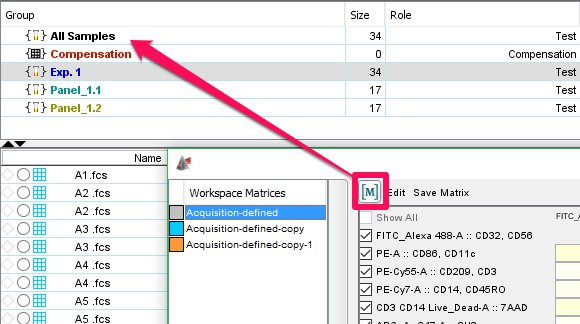
This matrix was calculated by your acquisition software. If you see a gray grid to the left of data files within FlowJo’s workspace, this indicates that a compensation matrix was imported via spillover keywords in that FCS file. Mousing over this icon brings up a tooltip that provides feedback on possible issues with controls currently assigned to a parameter. If you look to the left of the Parameter column in the wizard, you will see a colored dot.

If, instead, the message reads “Calculation Error,” This means FlowJo was unable to calculate the matrix from your given controls. You can also inspect the spillover matrix percentages calculated from your single-stained controls by clicking “View Matrix” at the top of the Compensation Wizard. Does this message say “Finalized”? If so, you can apply the matrix to your data by dragging the “” icon from the top left-hand corner of the wizard to individual samples or to groups within FlowJo’s workspace. In the top right-hand corner of the Compensation Wizard there is a message in blue. Pro-Tip: If you are using an unstained control as your universal negative, you can drag and drop the universal negative population from the unstained sample in your FlowJo workspace to the Negative column header in the compensation wizard-this automatically assigns that population as the negative control for all colors! If these autogates totally miss the mark, and you’d like to define them from scratch, you can do so in FlowJo’s workspace, then click the control population columns to the right of the parameters, and select your manually-defined populations to assign them to that color. Now, adjust the range gate(s) there to your desired location.

#Flowjo compensation matrix import windows#
If the auto-gated control populations need adjustment, you can simply click on the preview graph windows at the bottom of the Compensation Wizard to bring up a univariate histogram defining these populations. Are the autogates correctly defining negative and positive control populations? If samples are mismatched, or no sample was selected for a given parameter, click the parameter cell to the right of the parameter column and select the appropriate sample.ģ. Are the samples assigned to the correct corresponding colors? If your parameter is not on this list, this is a sure sign that the parameter of interest is not contained in each single-stain control sample within your workspace’s Compensation group, which is required in order to perform compensation calculations on a given parameter.Ģ. If there are parameters which were not automatically added to the wizard, click on the parameter column header, and find the option “Choose Parameters.” Within the resulting dialog box, select your parameters of interest. If there are parameters included that you do not wish to compensate, click on the Sample cell to the right of the unwanted color, and choose “Remove this Parameter.” Are the parameters in the Compensation Wizard correct? Users should now be very careful to check the following three items:ġ. Then, peak-finding algorithms will try to auto-gate negative and positive control populations within those samples. Opening the Compensation Wizard.Īt this point, FlowJo will perform some pretty cool magic tricks: First, it will attempt to automatically assign control samples to their appropriate colors. Click one of the two Compensation icons to open the Compensation Wizard:įigure 1.

Load your single-stained controls into FlowJo, and make sure they are all added to FlowJo’s Compensation group.
#Flowjo compensation matrix import professional#
This brief guide is to help users new to compensation calculations and experienced flow-maestros alike breeze through this process in a painless and professional fashion. The Compensation Wizard in FlowJo is one of the most frequently used platforms, and by extension potentially the greatest source of confusion on a per-cytometrist basis.


 0 kommentar(er)
0 kommentar(er)
